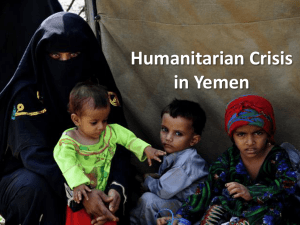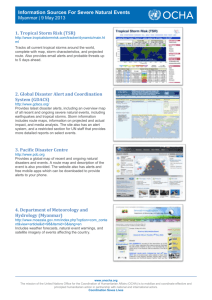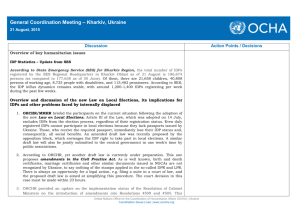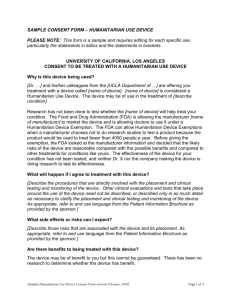sheltering devastated
advertisement
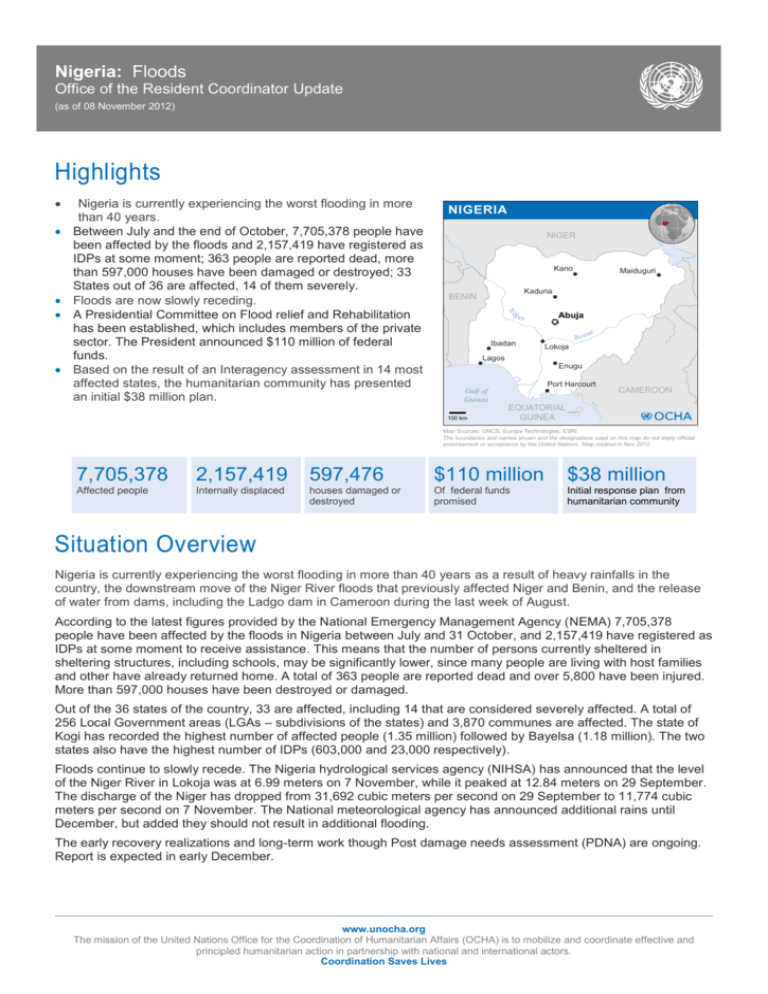
Nigeria: Floods Office of the Resident Coordinator Update (as of 08 November 2012) Highlights MALI NIGERIA NIGER Kano Maiduguri Kaduna BENIN ig N Nigeria is currently experiencing the worst flooding in more than 40 years. Between July and the end of October, 7,705,378 people have been affected by the floods and 2,157,419 have registered as IDPs at some moment; 363 people are reported dead, more than 597,000 houses have been damaged or destroyed; 33 States out of 36 are affected, 14 of them severely. Floods are now slowly receding. A Presidential Committee on Flood relief and Rehabilitation has been established, which includes members of the private sector. The President announced $110 million of federal funds. Based on the result of an Interagency assessment in 14 most affected states, the humanitarian community has presented an initial $38 million plan. er Ibadan Abuja B e nu e Lokoja Lagos Enugu Port Harcourt Gulf of Guinea 100 km CAMEROON EQUATORIAL GUINEA Map Sources: UNCS, Europa Technologies, ESRI. The boundaries and names shown and the designations used on this map do not imply official endorsement or acceptance by the United Nations. Map created in Nov 2012. 7,705,378 2,157,419 597,476 $110 million $38 million Affected people Internally displaced houses damaged or destroyed Of federal funds promised Initial response plan from humanitarian community Situation Overview Nigeria is currently experiencing the worst flooding in more than 40 years as a result of heavy rainfalls in the country, the downstream move of the Niger River floods that previously affected Niger and Benin, and the release of water from dams, including the Ladgo dam in Cameroon during the last week of August. According to the latest figures provided by the National Emergency Management Agency (NEMA) 7,705,378 people have been affected by the floods in Nigeria between July and 31 October, and 2,157,419 have registered as IDPs at some moment to receive assistance. This means that the number of persons currently sheltered in sheltering structures, including schools, may be significantly lower, since many people are living with host families and other have already returned home. A total of 363 people are reported dead and over 5,800 have been injured. More than 597,000 houses have been destroyed or damaged. Out of the 36 states of the country, 33 are affected, including 14 that are considered severely affected. A total of 256 Local Government areas (LGAs – subdivisions of the states) and 3,870 communes are affected. The state of Kogi has recorded the highest number of affected people (1.35 million) followed by Bayelsa (1.18 million). The two states also have the highest number of IDPs (603,000 and 23,000 respectively). Floods continue to slowly recede. The Nigeria hydrological services agency (NIHSA) has announced that the level of the Niger River in Lokoja was at 6.99 meters on 7 November, while it peaked at 12.84 meters on 29 September. The discharge of the Niger has dropped from 31,692 cubic meters per second on 29 September to 11,774 cubic meters per second on 7 November. The National meteorological agency has announced additional rains until December, but added they should not result in additional flooding. The early recovery realizations and long-term work though Post damage needs assessment (PDNA) are ongoing. Report is expected in early December. www.unocha.org The mission of the United Nations Office for the Coordination of Humanitarian Affairs (OCHA) is to mobilize and coordinate effective and principled humanitarian action in partnership with national and international actors. Coordination Saves Lives Country Emergency Situation Report No. 1 |2 Funding On 9 October, President Goodluck Ebelele Jonathan announced that the federal Government would provide Naira 17.6 billion (US$ 110 million) to be distributed to states depending on how affected they were. A Presidential Committee on Flood relief and Rehabilitation was established, which includes members of the private sector. The Committee will organize a major fundraising dinner on 8 November at the President’s house. According to media, the Committee aims to raise up to Naira 100 billion (approx. $637million), a total that would include both immediate relief and longer term reconstruction and rehabilitation. The International Federation of Red Cross and Red Crescent Societies have launched an Emergency Appeal Fund of US$ 216,561 (Nairas 34 million). This appeal will be used to help flooding affected people in Adamawa, Taraba, Kogi, Plateau, Katsina, Cross River, Jigawa, Kogi, Benue and Edo states. According to FTS, Sweden had given $152,672 for Flood response in areas of emergency shelter, relief, distributions, emergency health, WASH promotion, logistics and disaster risk reduction. As a regional response to serious flooding in Benin, Cameroon, Niger, Nigeria and Chad since the beginning of the rainy season, the European Commission has committed €1 million of humanitarian funding to over 95,000 of those worst affected. Much of the funding will go towards providing emergency shelter and basic household items to those who have lost nearly everything. All humanitarian partners, including donors and recipient agencies, are encouraged to inform OCHA's Financial Tracking Service (FTS - http://fts.unocha.org) of cash and in-kind contributions by e-mailing: fts@un.org Humanitarian Response Following the interagency assessment made 19-25 October in 14 states, the Humanitarian community presented on 1 November a US$ 38 million draft response plan to the Presidential Committee on Flood relief and Rehabilitation to fill the current gap in the response. The plan is based on a working figure of 2.1 million people in need of assistance. Sectors involved are: education; health; nutrition; water, sanitation and hygiene; protection; and shelter/NFI. Collection of information on 3W is ongoing. Requirements Sector Nairas US$ 40,730,000 259,425 Health 545,000,000 3,471,340 Nutrition 234,000,000 1,490,450 4,604,354,000 27,327,095 Protection 423,002,500 2,694,283 Shelter/NFI 118,897,275 750,938 Grand Total 5,965,983,775 Breakdown of requirement for the draft response plan 37,999,896 Education Water, sanitation and hygiene (WASH) Education Needs identified by the interagency assessment mission in 14 states Education activities have been severely disrupted 53% of schools in the communities visited are not available for schooling. Out of this total 77% are destroyed and 23% are occupied by IDPs. In some communities, the teacher/pupil ratio is about 1:400 (e.g. Plateau state). Lack of educational material. United Nations Office for the Coordination of Humanitarian Affairs (OCHA) Coordination Saves Lives | www.unocha.org Country Emergency Situation Report No. 1 |3 Response plan The response plan aims at the immediate restoration of Education through the promotion of access and continued learning in a safe protective environment by all children and adolescents in affected areas. Objectives are as follows: To ensure that schools are immediately restored for education use: IDPs occupying school premises should be allocated alternative accommodation in order to allow school activities to resume. To ensure that alternative learning spaces (where schools have been occupied) and learning materials (school tents, school and recreational kits, learners’ and ECD kits and educational materials) are available. To create awareness of the affected community on peace building/conflict resolution, violence and abuse prevention and increase their knowledge base and coping capacities. To ensure that culturally appropriate key communication messages on violence prevention, peace building and sanitation and hygiene available. To empower teachers, pre-school care providers and community-based paraprofessionals in affected communities with skills and knowledge to provide psychosocial support and Life skills Education to learners. Food Security Main needs identified by the interagency Humanitarian and Agricultural & Food Security assessments mission in 14 states There is limited access to market in some communities and prices of basic food communities have sharply increased. However, it is still early to assess the impact of flood on the food price index Food distribution in shelter structures is not regular. The food security situation has been eroded, particularly in areas where floods washed away the farmlands; irrigation infrastructure and bridges connecting production areas; Farmlands and storage facilities as well as livestock are washed away. Out of the major food crops (Rice, Yam, Cassava, Maize, sorghum) produced in affected states, Rice is the most affected, immediately followed by Cassava and Maize; The impact may not be felt immediately, because the country depends on imported rice, however the major rice producing areas have been devastated by flood; As part of immediate and short term needs, cash money should be distributed to farmers and fishermen to help them repair their damaged poultry, fish ponds and farm houses. There is also need to inputs in kind, such as livestock, poultry, seeds/seedlings or fingerlings, water pumps, tube wells, to allow farmers ans fishermen to restart production. Response plan The draft response plan presented to the Presidential committee does not include the food security sector. Ongoing response With support from the IFRC and other partners, the Nigeria Red Cross is providing support to 10,000 households in of Adamawa, Taraba, Kogi, Bauchi, Katsina, Cross River, Jigawa, Kogi, Benue and Edo States. This includes food. Health Main needs identified by the interagency assessment mission in 14 states In several states, health facilities have been damaged, limiting access to basic health services, especially in Bayelsa and Delta States. United Nations Office for the Coordination of Humanitarian Affairs (OCHA) Coordination Saves Lives | www.unocha.org Country Emergency Situation Report No. 1 |4 Medical staffs, supplies and commodities were generally inadequate. Prevalent health problems reported include diarrheal, malaria and typhoid. Response plan The response plan aims to prevent excess mortality and morbidity among the IDPs and host communities by restoring basic health services and supporting early detection and rapid response to communicable disease outbreaks. Objectives are as follows: Restore access to basic and referral health care including curative and preventive health services Continue assessments of the health situation and public health threats Strengthen surveillance of epidemic-prone diseases and response to outbreaks Support health partners through coordination and response planning to address the health needs of floodaffected populations Promote health Ongoing response operations MSF is providing assistance in Adamawa and Taraba states with mobile clinics. In Taraba state, MSF teams carried out 1,430 consultations in Mayorenewo and 10 nearby villages and locations where displaced people had settled, including Bandawa Virna, Zip, and Didango, providing primary and emergency health care, focusing on children under five and pregnant women. In Adamawa State, MSF mobile clinics treated 5,500 patients in 33 flooded villages and two internally displaced people’s camps in Numan and Borong. Soap and mosquito nets were also distributed to 2,200 beneficiaries. Nutrition Main needs identified by the interagency assessment mission in 14 states Access to Management of childhood illnesses ,including treatment of acute malnutrition were lacking Response plan The response plan aims to provide life-saving nutrition interventions and promotion of infant and young child feeding practices during emergency to ensure appropriate nutrition emergency response. The targeted beneficiaries are 49,060 children under five to be treated for severe acute malnutrition (SAM); and 327,067 caregivers/mothers of children 6-23 months to benefit from promotion of optimal infant and young child feeding practices to ensure adequate growth and development. Protection Main needs identified by the interagency assessment mission in 14 states Camp layout does not take into consideration protection concerns especially for women and children. Overcrowding is evident in all camps and communities creating high risk for sexual and gender based violence. Inadequate security measures in camps and communities Response plan The response plan aims to prevent and respond to abuse, exploitation and violence against children (directly or indirectly) affected by the flood; and to mitigate potential protection risks by closely coordinating with other sectors to ensure protection needs are given due considerations in all of their planned interventions and actions. The plan includes short term measures activities such as the establishment of protection coordination systems at state and federal levels for information sharing and follow up on protection concerns; the facilitation of initial United Nations Office for the Coordination of Humanitarian Affairs (OCHA) Coordination Saves Lives | www.unocha.org Country Emergency Situation Report No. 1 |5 protection interventions; provision of facilities for children and their protection; SGBV protocol for reporting and assistance to survivals; the identification of women of reproductive age and distribution of hygiene kits; monitoring of the distribution of relief items to ensure it is done without discrimination; creation of sensitization mechanisms in IDP camps and communities on areas of protection concerns; the monitoring of protection incidents. The plan also provides for Medium and Longer term measures: Profiling of IDPs including disaggregation of IDP population; continued assistance until return and resettlement phase; Continued counseling and psychosocial support to traumatized victims; and continued advocacy and monitoring of human rights principles. Shelter / NFI Main needs identified by the interagency assessment mission in 14 states Approximately 63% of the IDPs are living with host families while 37% are in camp like situation. There is overcrowding and overstretching of family resources. IDPs camps are mostly located in schools and public places. NFIs have not been distributed in most rural areas. E.g. Kogi, Bayelsa, Benue and Delta. Response plan The response plan aims to provide adequate and appropriate shelter for IDPs families and NFIs for their specific needs. In the short term, this includes the provision of Tents for 350,000 families (one per family); assistance to vulnerable groups to build shelters; distribution of Basic NFIs (Blankets, Sleeping mats/Mattresses, Mosquito Nets, Cooking Sets, 20lits Jerry Cans/Buckets, Soap, Clothes, Lanterns) to 350,000 families; Sensitization/awareness campaigns in camps and communities to support re-building activities and against overcrowding; Monitoring of shelter standards and practices; the establishment of an operation coordination system at SEMA level. UNFPA will provide Mama Kits for women in reproductive age. Medium to long-term activities will include provision of construction material for 350,000 families for re-construction of individual family houses and training and support to construction activities. Ongoing response With support from the IFRC and other partners, the Nigeria Red Cross is providing support to 10,000 households in Adamawa, Taraba, Kogi, Bauchi, Katsina, Cross River, Jigawa, Kogi, Benue and Edo States. This support includes non-food items such as mosquito nets, blankets, sleeping mats, jerry cans, buckets, soaps, shelter tool kits, tarpaulins, hygiene kits and kitchen sets. Water, Sanitation and Hygiene Needs identified by the interagency assessment mission in 14 states In almost all the communities, there is no provision of clean water. 63% of drinking and cooking water comes from streams or unprotected wells. Due to the lack of clean water epidemic is looming. Inadequate sanitation has been reported in almost all the host communities and camps visited by the teams. Response plan The response plan aims to ensure provision of safe water, proper sanitation and improved hygiene for the affected population in IDP camps and communities. Objectives are as follows: To ensure the availability of minimum safe drinking water supply (15 lit/capita/day) at a maximum distance of 500m) taking into account privacy, dignity, and security of most vulnerable segment of people including girls and women in IDP Camps, affected and host communities. United Nations Office for the Coordination of Humanitarian Affairs (OCHA) Coordination Saves Lives | www.unocha.org Country Emergency Situation Report No. 1 |6 To ensure people have adequate numbers of toilets, sufficiently close to their dwellings, to allow them safe and acceptable access at all times of day and night To facilitate dissemination of key messages on hygiene including hand washing Ongoing response With support from the IFRC and other partners, the Nigeria Red Cross is providing support to 10,000 households in of Adamawa, Taraba, Kogi, Bauchi, Katsina, Cross River, Jigawa, Kogi, Benue and Edo States. This water purification tablets (aqua tabs) and Oral Rehydration Salt (ORS). General Coordination A Presidential Committee on Flood relief and Rehabilitation has been established. The committee includes Ministries, MPs, state agencies such as NEMA, representatives of donors (USAID, World Bank, EU, DFID) the UN System (through the RC) and members of the private sector. The committee is chaired by Nigerian businessman Aliko Dangote. A joint interagency assessment mission took place 19-25 October in 14 states - Bayelsa, Kogi, Adamawa, Delta, Edo, Niger, Taraba, Benue, Anambra, Imo, Plateau, Kwara, Kebbi and Jigawa. Initial finding show that many communities are completely washed away and inaccessible, especially in Bayelsa, Kogi and Delta. Many public infrastructure such schools, health centres, roads and bridges have been completely destroyed. Most of the IDPs have lost their livelihood and in 82% of the communities visited, the food insecurity is severe or very severe. There is a high risk of outbreak of epidemics, populations having very limited access to clean water and to adequate sanitation. A Joint Agricultural and Food Security Assessment was organized 19 October – 2 November in 14 states to provide an informed estimate of losses incurred by the agriculture sector due to the floods. Based on losses in staple food production against initial estimates and harvest losses as well as domestic requirements, the Assessment provides the implications of these food losses on national and household food security so that appropriate actions can be taken. The assessment makes recommendations on the needed response to cover immediate and medium term food and rehabilitation needs as appropriate. For further information, please contact: Choice Okoro-Oloyede, Head of UNOCHA Humanitarian Advisory Team, okoroc@un.org, +234 8166973847 Remi Dourlot, Public Information Officer, dourlot@un.org, +234 81 59 50 23 30 For more information, please visit www.ochaonline.un.org/rowca To be added or deleted from this Sit Rep mailing list, please e-mail: ndiour@un.org United Nations Office for the Coordination of Humanitarian Affairs (OCHA) Coordination Saves Lives | www.unocha.org

